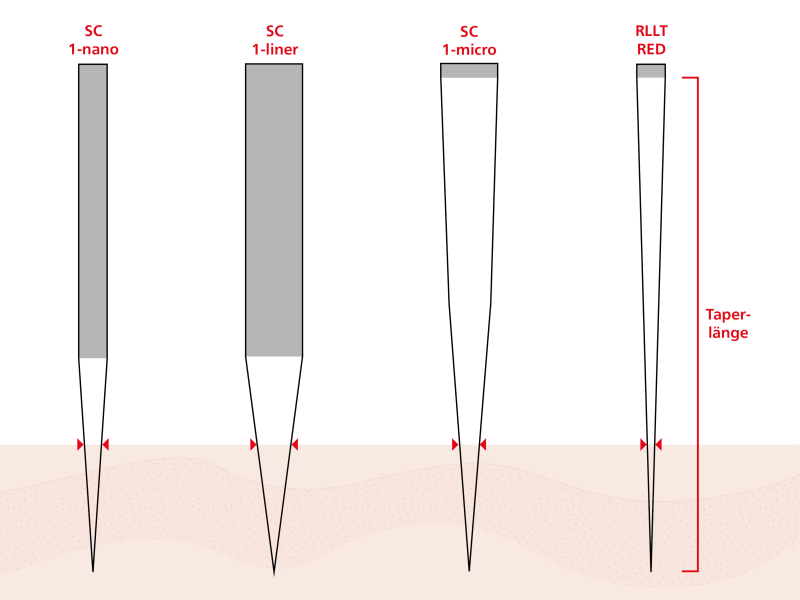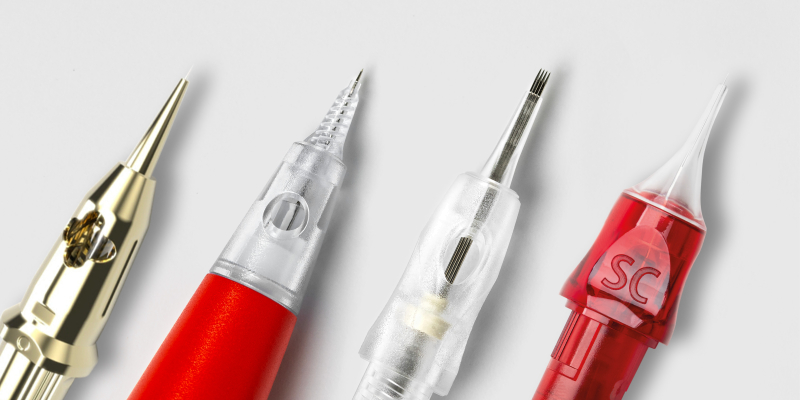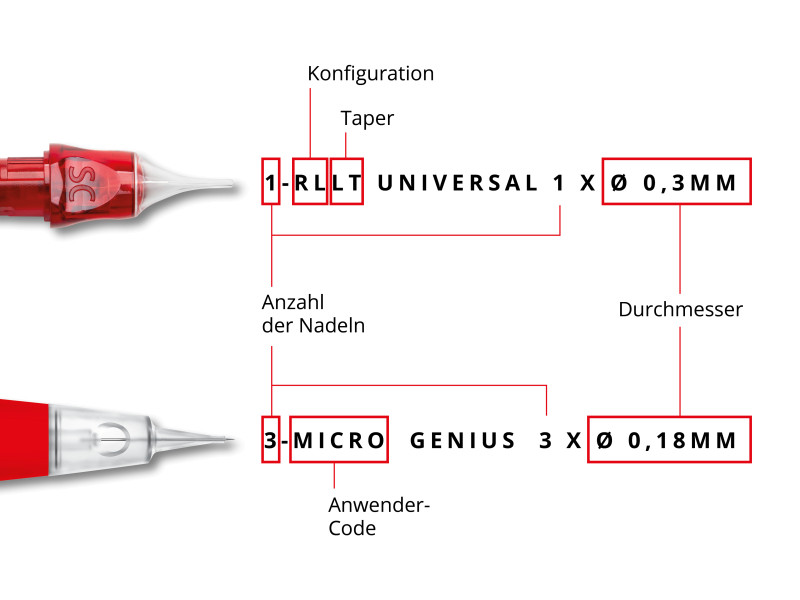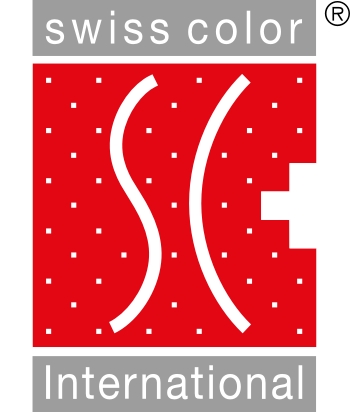The SC hygiene module and needle guide
Published on September 29, 2023 / Last updated on October 15, 2025
The hygiene module is the interface between technology, feeling, and creativity—and is therefore crucial for the aesthetic result on the skin. With the right module, you can achieve precise lines, smooth transitions, and efficient pigmentation with fewer follow-up treatments.
Four factors determine the result and style of pigmentation:
1. The number
2. The configuration
3. The diameter
4. The taper
Explore your personal favorite modules and expand your creativity!
For further information, please contact us by email at info@swiss-color.com or by phone at +43 5332 56671.
We look forward to hearing from you!
Your Swiss Color Team
1. Number of needles
...determines how much pigment is deposited per stroke. Multiple needles allow for bolder lines, faster shading and filling, while a single needle is ideal for fine lines and detailed work.
- Swiss Color hygiene modules are available with 1 to 5 needles.
- The first digit in the cartridge designation always indicates the number of needles.
2. Needle configuration
...defines application possibilities, pigment flow, and technique. The configuration reveals the arrangement of the needles in the cartridge—i.e., whether they are soldered in a round, flat, or slanted pattern—and thus influences line formation, color density, and skin protection.
- ROUND LINER (RL)
These hygiene cartridges are ideal for fine lines, hairs, or precise contours. The needles are closely spaced in a round arrangement, resulting in fine, controlled pigment delivery. The line thickness varies depending on the number of needles and diameter – from ultra-fine nano lines to more visible contours.
Use: Eyebrow hairs, eyeliner, detailed work - ROUND SHADER (RS)
Here, the needles are also arranged in a circle, but with more space between them. This allows more pigment to be deposited in less time, creating a softer, pixelated effect.
Use: Lip shading, ombre brows, eyelid shading. - FLAT (FL)
The needles are arranged in a straight line next to each other, allowing more pigment to be evenly applied to the skin with one movement. Flats create clear, defined lines or targeted color fills, depending on the technique.
Use: Eyeliner, contours, precise lip lines. - MAGNUM (MG)
Magnum cartridges consist of two offset rows of flat needles – similar to two flat rows stacked on top of each other. They enable broader, even pigment distribution and are ideal for shading, filling areas, and areola or camouflage work.
Use: Lip shading, areola, scalp, camouflage. - SLOPE (SL)
In this configuration, needles of different lengths form a sloping edge – a hybrid between Round Liner and Flat. Depending on the angle, a single tip can be used for fine work or several needles can be used simultaneously for soft shading. Nano Slope cartridges are considered a digital transfer of the microblading technique (digital blading) and enable both ultra-fine lines and multidimensional shading.
Use: Hybrid brows, fine lines, soft shading.

4. Taper (needle tip shape)
...describes the length and shape of the cut at the needle tip—i.e., the area where the needle tapers to a fine point. The taper influences the insertion angle, penetration depth, and pigment flow and, in combination with the needle diameter, determines how precisely, gently, or intensively the needle can be used.
- Short Taper (ST): wider tip, high pigment volume, stronger skin irritation
- Medium Taper (MT): balanced control, ideal for versatile PMU techniques
- Long / Extra Long Taper (LT / XLT): very fine cut, maximum precision with minimal trauma
Swiss Color hygiene modules are optimized for precise, tissue-friendly work and are predominantly equipped with medium to long taper shapes. The polished, sharp taper ensures even pigment deposition and minimizes skin irritation – in contrast to roughened tattoo needles, which cause more pigment but also more irritation.
Note: With the exception of the 1-micro module (long taper), all SC Classic and Genius hygiene modules are equipped with a medium taper (1.5 mm).

Highlights of our hygiene module range include the capillary modules – with enlarged pigment reservoirs and optimized color flow for greater efficiency, more precise work, and faster results.
Available as:
- 1-liner capillary Genius hygiene cartridge
- 3-micro capillary Cheyenne (Universal)
Highlights of our hygiene module range include the capillary modules – with enlarged pigment reservoirs and optimized color flow for greater efficiency, more precise work, and faster results.
Available as:
- 1-liner capillary Genius hygiene cartridge
- 3-micro capillary Cheyenne (Universal)

3. Needle diameter
...has a significant influence on how much pigment a needle absorbs, how deeply it penetrates the skin, and how precise or soft the result appears.
- Thinner needles (e.g., 0.18–0.25 mm) are particularly flexible and ideal for precise detail work such as fine lines, hairs, and soft shading. The lower amount of pigment and gentler skin penetration create a natural, transparent result – ideal for sensitive skin or thin areas such as eyelids.
- Thicker needles (e.g., 0.30–0.40 mm) are more stable and transport more pigment into the skin. They create stronger lines, denser color fillings, and are better suited for lips, camouflage, or scalp, as well as oily, thicker, or resistant skin types.
In Swiss Color hygiene modules, the needle diameter is indicated at the end of the module designation. Available in 0.18 to 0.40 mm – from nano precision to maximum pigment density.
